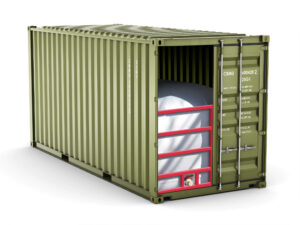ISO Tank, Tank Container, ISOtainers, Seatainer, Intermodal Container
ISO Tank, also known as ISOtainers or intermodal containers are built to ISO (International Organization for Standardization) standards and used to transport bulk cargo. Suitable for a variety of transportation modes such as truck, ship, and rail, the hazardous and non-hazardous products transported in these stainless steel shipping containers are often insulated by layers of polyurethane and aluminum within the container. Standardization in size and shape allows for the structural integrity required for moving using heavy equipment and ensures the container will withstand harsh environmental conditions during transport.
ISO Tanks are used to transport a wide variety of products including:
- Food-grade liquids
- Corrosive liquids
- Explosives
- Toxic & flammable liquids
- Oil & gas
- Petroleum products
An ISO Tank is made up of a cylindrical vessel mounted inside a rectangular steel frame, making it easy to stack uniformly and safely when necessary. Standard ISO dimensions are 20’ x 8’ x 8’6”, although depending upon the product being transported, smaller and larger containers are also common.
Regular inspections ensure the safety of ISO Tank which often transport chemicals and other hazardous liquids and gasses. ISO Tanks come in a variety of styles to meet the loading requirements for the products they are designed to transport including:
- Insulated – suitable for the transport of temperature-sensitive products, has insulated walls, but no refrigeration.
- Tank – used to transport liquid or bulk materials, built to the same standard dimensions as other ISO containers, but are cylindrical vessels mounted in a rectangular steel framework.
- Open top – shaped like a box, loaded from the top or end, designed to carry hard to load materials such as coal or grain.
- Flat rack – used to transport heavy machinery, no side walls, may have end bulkheads, often collapsible.
Benefits of ISO tank containers:
- Cost-effective. ISO tank containers are easily transported from ship to rail to the truck using standard handling equipment.
- Safety. Cargo is easily contained, keeping hazardous contents off public roads, reducing the likelihood of accidents and spills.
- Consistency. Temperature-sensitive cargo can be monitored and managed easily.
- Reliability. Manufactured from stainless steel which is naturally resistant to corrosion using tank liners to mitigate fluctuations in pressure and temperature.
- Efficient. Standardization allows for uniform stacking which makes handling and storage more efficient.
- Eco-friendly. A long lifespan and the reduction of additional packaging materials required for safe transport reduces the carbon footprint by nearly almost 50% when compared to an equivalent drummed shipment on certain long-haul routes.
ISO Tank, Rolling Stock & Loading Safety
What you need to know about the General Duty Clause
Any facility with operators charged with loading or unloading ISO Tank must create and carefully implement safety protocols that ensure safety at all costs. It is important to note that once ISO Tank leaves the dock in the United States they are considered rolling stock. OSHA’s fall protection and prevention requirements for rolling stock have been confusing and consistently unenforced for decades. In an effort to remedy the lack of information available on the subject, OSHA requested input from industry leaders and addressed widespread concerns in a public hearing held in January of 2011. As of October 2020, OSHA has yet to release any updates, and as far as we know, proposed changes from January 2017 are still under review.
The General Duty Clause Section 5(a)(1) of the OSHAct requires you to provide your employees with a workplace free from hazards likely to cause death or physical harm. It is important to note that a 1996 OSHA memorandum from John B. Miles states that, “The current fall protection standard in general industry (Subpart D) does not specifically address fall hazards from the tops of rolling stock. The new proposed fall protection standard, 55 Fed. Reg. 13360, explicitly excludes rolling stock from coverage. The enforcement policy of the Agency, consequently, is that falls from rolling stock also will not be cited under Subpart D. Additionally, it would not be appropriate to use the personal protection equipment standard, 29 CFR 1910.132(d), to cite exposure to fall hazards from the tops of rolling stock unless employees are working atop stock that is positioned inside of or contiguous to a building or other structure where the installation of fall protection is feasible. In such cases, fall protection systems often can be and, in fact, are used in many facilities in the industry.”
It’s also wise to use 1926.501(b)(15) as a guideline, which states, “each employee on a walking/working surface 6 feet (1.8m) or more above lower levels shall be protected from falling by a guardrail system, safety net system, or personal fall arrest system.”
ISOtainer Safety Challenges
Operator loading and unloading safety are dependent upon your familiarity with the challenges presented by ISO Tank. Unsafe workarounds used to manage non-standard size configurations are the biggest culprit in increasing your company’s liability and compromising your compliance with OSHA standards. This risk can be mitigated by creating fall protection and fall prevention systems that keep operators working safely and efficiently.
Configuration issues are also created by aftermarket modifications made to ISO Tank which compromise the ability to stack and store containers safely. Although the standard ISO Tank size is common, there are a number of variations across vertical markets to watch out for. Containers send out of the US into international waters may also have to meet foreign standards that differ from domestic specifications.
In the transport process, ISO tanks are moved using large cranes and forklifts specifically made to relocate these large containers so they can be stacked properly on container ships. Once they are ready to leave the ship, trucks transport them to rail cars or hit the road for their final destination. Once the ISO Tank reaches the customer, they must be unloaded by operators. Hoses and loading/unloading system fittings help in the process to remove liquid products from the ISO Tank.
Loading and unloading safety protocols for ISO Tank vary depending upon the product being transported. Open-top containers that usually carry materials such as coal or grain are usually top-loaded whereas dry freight ISO Tank is usually front-loaded. Liquid products are always loaded and unloaded using a hose or loading arm. Fall prevention such as a loading safety cage and loading gangway is necessary for operators to eliminate the risk of a fall while standing on top of the container. Handrails and safety gates offer fall protection when gaps between the sides of the container and the loading area exist. Creating and implementing a safe loading and unloading environment for operators at your facility is essential to reducing your risk for a workplace injury or fatality and increasing throughput for your business.

Flexitanks – The Isotainer Alternative
Flexitanks are standard intermodal containers with a bladder or bag for transporting and storing non-regulated liquids. With the bladder inside the 20′ container and filled, fluids are protected from moving and punctures. The internal bladder is suitable for food-grade liquids and nonhazardous chemicals such as base oils, beer, wine, molasses, glycerine, fruit juices, latex, egg products, water, oils, bio-diesel, edible oils, wine, non-hazardous pharmaceuticals, chemicals, and industrial products.


























